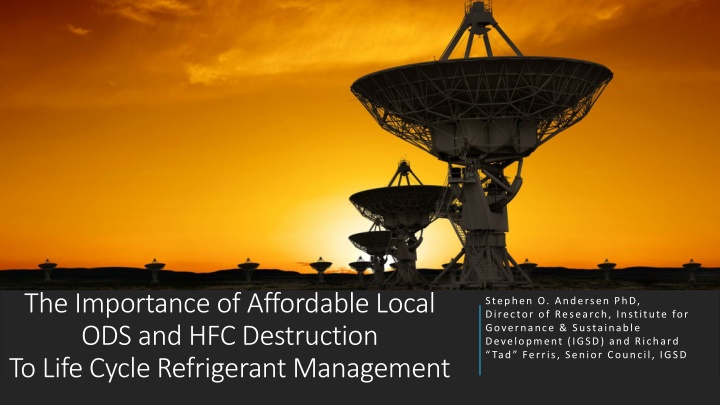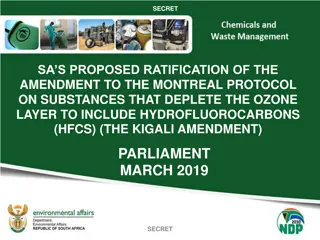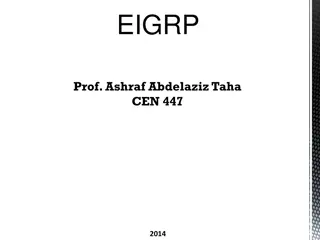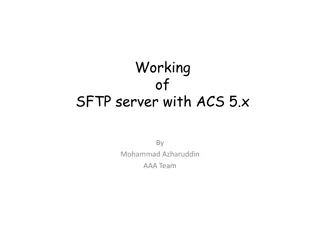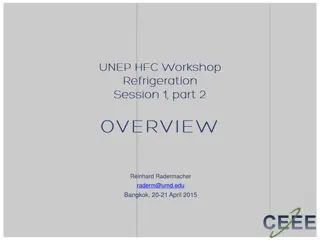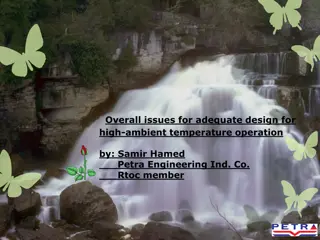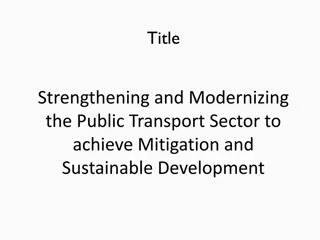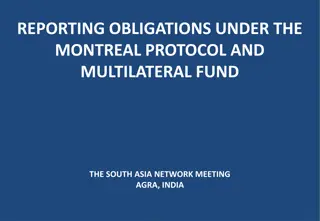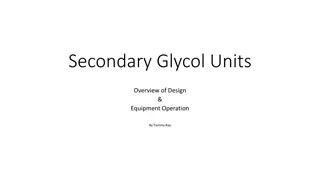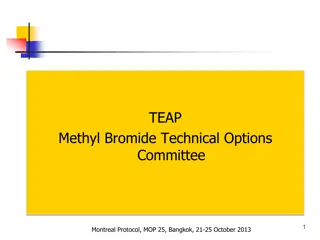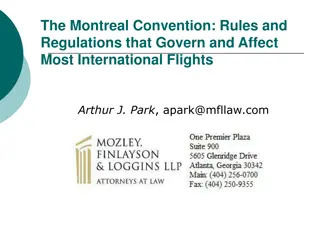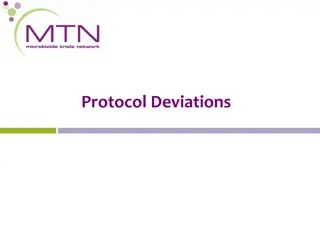Sustainable Refrigerant Management: Local Destruction & Montreal Protocol Strengthening
Explore the significance of affordable local destruction of ozone-depleting substances (ODSs) and HFCs for life cycle refrigerant management. Learn about the importance of strengthening the Montreal Protocol to mitigate climate impacts. Discover key takeaways for preventing climate tipping points, promoting sustainable practices, and enhancing Earth's survival through effective refrigerant phase-down strategies.
Download Presentation

Please find below an Image/Link to download the presentation.
The content on the website is provided AS IS for your information and personal use only. It may not be sold, licensed, or shared on other websites without obtaining consent from the author.If you encounter any issues during the download, it is possible that the publisher has removed the file from their server.
You are allowed to download the files provided on this website for personal or commercial use, subject to the condition that they are used lawfully. All files are the property of their respective owners.
The content on the website is provided AS IS for your information and personal use only. It may not be sold, licensed, or shared on other websites without obtaining consent from the author.
E N D
Presentation Transcript
The Importance of Affordable Local ODS and HFC Destruction To Life Cycle Refrigerant Management Stephen O. Andersen PhD, Director of Research, Institute for Governance & Sustainable Development (IGSD) and Richard Tad Ferris, Senior Council, IGSD
Presentation Outline and Take-Away Every Reason to Strengthen the Montreal Protocol to Avoid Climate Tipping Points Affordable Local Destruction of ozone-depleting substances (ODSs) and HFCs Makes Live Cycle Refrigerant Management Profitable with Desired High Market Penetration Some A5 Parties have Local Destruction Facilities, But Most Do Not Cement Kiln Destruction Can Be Less Expensive While Achieving High Standards of Exhaust Gas Safety
Every Reason to Strengthen the Montreal Protocol for Earth Survival! Prevent 0.5 C by phase down of HFCs in new equipment! Prevent 0.5 C more with super-efficient refrigeration and air conditioning! Prevent MUCH MORE warming by replacing inefficient ACs and destroying refrigerant! Stop dumping of inefficient cooling equipment with obsolete HCFC and HFC refrigerants! Phase down nitrous oxide (N2O) ozone-depleting greenhouse gases (OD GHGs) Narrow the Feedstock Exemption to protect ozone and climate; reduce plastic, PFAS, and TFA pollution; and protect workers and communities from toxic manufacturing and waste!
Status Quo Destruction in A5 Parties Next in this Side Event Makoto Kato Will Report the Outcome of an Important Workshop Held Last Month in Bangkok Mr. Kato is a Member, Board of Directors of the Japan Overseas Environmental Cooperation Center and Head, Secretariat of the Initiative on Fluorocarbons Life Cycle Management (IFL)
Informal Cement Kiln Working Group Respected and Influential Volunteer Members* Dr. Stephen O. Andersen (USA), Dr. Suely Carvalho (Brazil), Richard J. Cooke (Canada), Mohamed Rida Derder (Morocco), Richard Tad Ferris (USA), Marco Gonzalez (Costa Rica), Makoto Kato (Japan), Dr. Helen Tope (Australia), Dr. Viraj Vithoontien (Thailand), and Catherine Yang (Taiwan) Working toward Spring 2024 Publication Presenting Policy Relevant Technical, Economic, and Institutional Information * The findings of the Informal Cement Kiln Working Group may not necessarily reflect the views of the organizations where they are employed
Preliminary Cement Kiln Findings High cost of destruction limits recovery and reclaim and discourages confiscating illegally traded substances A5 Parties cannot afford to destroy Destruction costs are high where ODS and HFC waste must be shipped beyond borders with added cost of storage, packaging, permitting, shipping, and destruction by non-A5 private enterprises Local cement kilns and shared responsibility can dramatically reduce the total costs of destruction driving refrigerant recovery and reducing illegal trade Local cement kiln destruction supports projects that replace improperly installed and maintained inefficient cooling equipment depending on obsolete refrigerants The Montreal Protocol can be strengthened to recovery, reuse, and destroy controlled substances with capacity building, finance, flexibility, networking, and training
Why Refrigerants are Rarely Destroyed In most cases the value of recovered refrigerant is less than the cost of recovery & reclamation The cost of cleaning up used refrigerant is often higher than the price of new refrigerant The carbon value of refrigerant destruction is less than the cost of recovery, bureaucratic paperwork, and destruction in far-away hazardous waste incinerators typically designed to destroy 99.999% of any chemical substance Small businesses find it impossible to jump through all the hoops and keep any money in their pockets Procrastination on climate action discourages even low-cost and profitable destruction
How to Reduce the Cost of Destruction? Replace and install many ACs all at once so that technicians can undertake other tasks while the recovery machines evacuate the old refrigerant Reward every company in the chain-of-custody with financial and carbon footprint benefits Pay technicians on delivery rather than after destruction (pay by the kilogram on a basis of ODP and GWP of any mixture determined by a portable refrigerant identifier) Consolidate the refrigerants for delivery at a local cement kiln where destruction can be undertaken when the incremental cost and combustion emissions are minimized
Advantage of Cement Kiln Destruction Cement kilns already deployed in most countries Local control over operations and efficient coordination with authorities Low cost kiln modification to destroy ODSs and HFCs Local jobs in recovery, transportation, management and destruction Each country taking responsibility for its own waste and each rewarded with NDC accounting Simplicity and lower cost encourages ODS and HFC recovery and destruction
Disadvantages of Cement Kiln Destruction Kiln owners may want contracts for reliable ODS and HFC supply before making necessary modifications for destruction Kiln authorities will need to be trained in operation, verification, and record keeping Owners of sophisticated destruction facilities in developed countries may discourage this competition
Big and Brave Thinking on Destruction Does the reduction in hazardous powerplant emissions from AC replacement with super-efficiency offset the relatively small hazardous cement kiln emissions? Can experts help Parties to the Montreal Protocol come to see the importance of low-cost ODS and HFC destruction necessary for climate protection?
ODS Waste Disposal Projects Funded by the Montreal Protocol Multilateral Fund ODS Waste Disposal Projects Funded by the Montreal Protocol Multilateral Fund Country Type of Project Date completed or status Cancelled at 79thExCom Algeria Pilot demonstration project on ODS waste management and disposal Brazil Pilot demonstration project on ODS waste management and disposal Project to be completed by December 2022 China Pilot demonstration project on ODS waste management and disposal Final report submitted April 2018 Colombia Final report submitted April 2018 Demonstration project on end of life ODS management and destruction Cuba Pilot demonstration project on ODS waste management and disposal Final report submitted May 2019 Georgia Pilot demonstration project on ODS waste management and disposal Final report submitted May 2017 Ghana Pilot demonstration project on ODS waste management and disposal Final report submitted May 2017 Indonesia Project preparation for a pilot demonstration project for ODS waste management and disposal for Indonesia Final report submitted March 2014 Lebanon Pilot demonstration project on ODS waste management and disposal Project deadline extended to June 2019 Mexico Demonstration project for disposal of unwanted ODS Final report submitted September 2017 Nepal Demonstration project for disposal of unwanted ODS Final report submitted May 2017 Nigeria Demonstration project for disposal of unwanted ODS Final report submitted April 2018 Turkey Demonstration project for disposal of unwanted ODS Final report submitted April 2018 Philippines Project preparation for a pilot demonstration project for ODS waste management and disposal for the Philippines Final report submitted February 2014 Europe & Central Asia Demonstration of a regional strategy for ODS waste management and disposal in Europe and Central Asia Final report submitted September 2017
Montreal Protocol Destruction Decisions (1) I/12F: Clarification of terms and definitions: destruction II/11: Destruction technologies III/10: Destruction technologies IV/11: Destruction technologies IV/26: International recycled halon bank management V/26: Destruction technologies VII/35: Destruction technology
Montreal Protocol Destruction Decisions (2) XII/8: Disposal of controlled substances XIV/6: Status of destruction technologies of ozone depleting substances, including an assessment of their environmental and economic performance, and commercial viability XV/9: Status of destruction technologies for ozone depleting substances and code of good housekeeping XV/10:Handling and destruction of foams containing ozone depleting substances at the end of their life XVI/15: Review of approved destruction technologies pursuant to decision XIV/6 of the parties
Montreal Protocol Destruction Decisions (3) XVII/17: concentrated and diluted sources of ozone depleting substances Technical and financial implications of the environmentally sound destruction of XVII/18: meeting of experts on destruction Request for assistance of the Technology and Economic Assessment Panel for the XVIII/9: Review of draft terms of reference for case studies called for under decision XXI/2: Environmentally sound management of banks of ozone depleting substances XXII/10: Destruction technologies with regard to ozone-depleting substances XXIII/12: Adoption of new destruction technologies for ozone-depleting substances XXIX/4: Destruction technologies for controlled substances
TEAP Task Force Reports on Destruction 2018 TEAP Task Force on Destruction Technologies for Controlled Substances 2002 TEAP Task Force on Destruction
